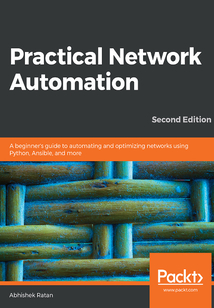舉報 

會員
Practical Network Automation
NetworkautomationistheuseofITcontrolstosuperviseandcarryouteverydaynetworkmanagementfunctions.Itplaysakeyroleinnetworkvirtualizationtechnologiesandnetworkfunctions.Thebookstartsbyprovidinganintroductiontonetworkautomation,anditsapplications,whichincludeintegratingDevOpstoolstoautomatethenetworkefficiently.Itthenguidesyouthroughdifferentnetworkautomationtasksandcoversvariousdatadiggingandperformingtaskssuchasensuringgoldenstateconfigurationsusingtemplates,interfaceparsing.ThisbookalsofocusesonIntelligentOperationsusingArtificialIntelligenceandtroubleshootingusingchatbotsandvoicecommands.ThebookthenmovesontotheuseofPythonandthemanagementofSSHkeysformachine-to-machine(M2M)communication,allfollowedbypracticalusecases.ThebookalsocoverstheimportanceofAnsiblefornetworkautomation,includingbestpracticesinautomation;waystotestautomatednetworksusingtoolssuchasPuppet,SaltStack,andChef;andotherimportanttechniques.Throughpracticaluse-casesandexamples,thisbookwillacquaintyouwiththevariousaspectsofnetworkautomation.Itwillgiveyouthesolidfoundationyouneedtoautomateyourownnetworkwithoutanyhassle.
目錄(129章)
倒序
- coverpage
- Title Page
- Copyright and Credits
- Practical Network Automation Second Edition
- About Packt
- Why subscribe?
- Packt.com
- Contributors
- About the author
- About the reviewer
- Packt is searching for authors like you
- Preface
- Who this book is for
- What this book covers
- To get the most out of this book
- Download the example code files
- Download the color images
- Conventions used
- Get in touch
- Reviews
- Fundamental Concepts of Network Automation
- Technical requirements
- A readable script
- Basic programs
- Validating an IPv4 address
- Making the right choice
- Hiding credentials
- Accessing APIs
- Using regular expressions (regex)
- Handling files
- Making a decision (Python or PowerShell)
- API access
- Interacting with local machines
- Introduction to code check-in and its importance
- Git installation and initialization
- Code check-in
- Sample use cases
- First use case
- Second use case
- Summary
- Questions
- Python Automation for Network Engineers
- Technical requirements
- Interacting with network devices
- Network device configuration using template
- Multithreading
- Use cases
- Using regular expressions (regex)
- Creating loopback interface
- Dynamic configuration updates
- Summary
- Questions
- Ansible and Network Templatizations
- Technical requirements
- Ansible and network templates
- Introduction to ad hoc commands
- Ansible playbooks
- Playbook examples
- Ping to a particular IP from all routers
- Section 1 – defining the scope of script
- Section 2 – defining what to execute (define the task)
- Ping to multiple IPs from all routers
- Section 1 – basic declarations
- Section 2 – declaring variables
- Section 3 – executing the task
- Section 4 – validations
- Network templates
- Step 1 – identifying the number of users the device is going to serve
- Step 2 – identifying the right configuration based upon the SKU
- Step 3 – identifying the role of the device
- Python integration
- Chef and Puppet
- Chef
- Step 1 – creating the recipe
- Step 2 – uploading the recipe
- Step 3 – adding the recipe to the run-list
- Step 4 – running the recipe
- Puppet
- Chef/Puppet/Ansible comparison
- Summary
- Questions
- Using Artificial Intelligence in Operations
- Technical requirements
- AI in IT operations
- Key pillars in AIOps
- Data source
- Structured data
- Non-structured data
- Data collector
- Data analysis
- Machine Learning (ML)
- Example of linear regression
- Intelligent remediation
- Application and use cases
- Summary
- Questions
- Web Framework for Automation Triggers
- Technical requirements
- Web framework
- Falcon
- Encoding and decoding
- Calling the web framework
- Sample use case
- Summary
- Questions
- Continual Integration
- Technical requirements
- Remediation using intelligent triggers
- Step 1 – ensuring Splunk is configured to receive the data
- Step 2 – validating the data (sample data)
- Step 3 – writing script
- Standardizing configurations on scale
- Chatbot interactions
- Use cases
- Interacting with SolarWinds
- Configuring Open Shortest Path First (OSPF) through Python
- Autonomous System Number (ASN) in BGP
- Validating the IPv4 and IPv6 addresses
- Summary
- Questions
- Assessment
- Chapter 1: Fundamental Concepts of Network Automation
- Chapter 2: Python Automation for Network Engineers
- Chapter 3: Ansible and Network Templatizations
- Chapter 4: Using Artificial Intelligence in Operations
- Chapter 5: Web Framework for Automation Triggers
- Chapter 6: Continual Integration
- Other Books You May Enjoy
- Leave a review - let other readers know what you think 更新時間:2021-07-02 14:53:30
推薦閱讀
- 數據展現的藝術
- 大學計算機基礎:基礎理論篇
- 嵌入式系統應用
- 錯覺:AI 如何通過數據挖掘誤導我們
- Hands-On Machine Learning with TensorFlow.js
- 電腦上網直通車
- 四向穿梭式自動化密集倉儲系統的設計與控制
- 水晶石精粹:3ds max & ZBrush三維數字靜幀藝術
- 可編程序控制器應用實訓(三菱機型)
- 大學C/C++語言程序設計基礎
- 我也能做CTO之程序員職業規劃
- 深度學習與目標檢測
- Excel 2010函數與公式速查手冊
- 從零開始學SQL Server
- Linux Shell編程從初學到精通
- 嵌入式Linux系統實用開發
- 大數據素質讀本
- Windows 7故障與技巧200例
- QTP自動化測試實踐
- Flink內核原理與實現
- Building Analytics Teams
- S7-200系列PLC應用技術
- Photoshop CS6兒童數碼照片處理達人秘笈
- 組態控制技術實訓教程(MCGS)
- Mastering PostGIS
- Excel Programming with VBA Starter
- 計算機控制技術(MCGS實現)
- PHP動態網站開發
- 數據庫系統管理初步
- C51單片機編程與應用

